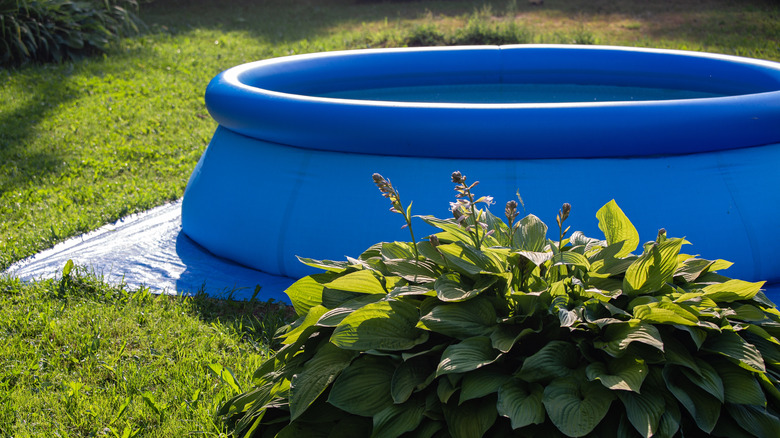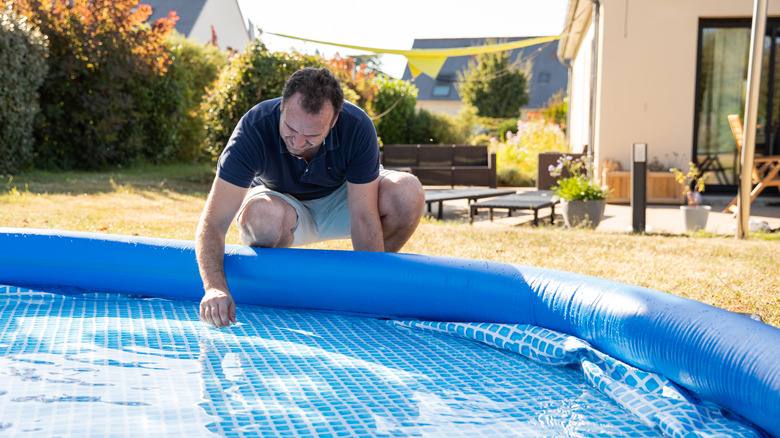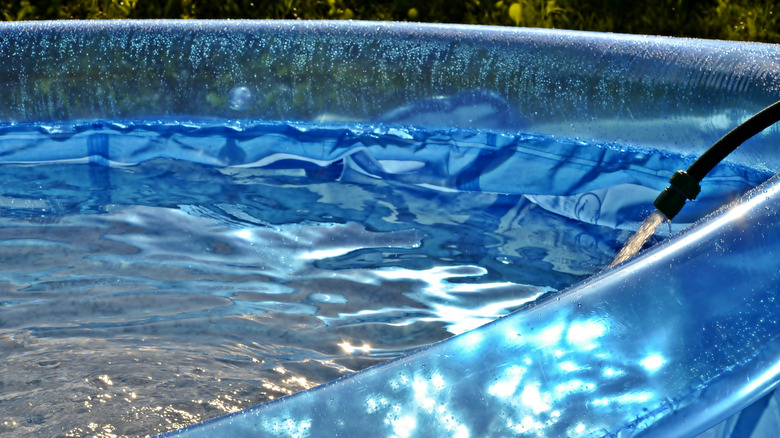How To Prep Your Lawn For Pool Season So It Doesn't Die
Every year, families look forward to the perfect time to open the pool in their backyard, making it the centerpiece of many outdoor get-togethers. Later into the season, however, many pool owners are sad to discover that their lovely green grass has gone yellow or sparse around the pool area, ruining the look of their yard.
Why does this happen? Well, inflatable pools sit on top of the grass, compacting the soil, blocking airflow, and limiting sunlight — all of which weaken grass over time and ruin the overall look of your yard. This, combined with excess moisture, creates an environment where grass struggles to survive. Even with the most careful preparation ahead of time, there's no way around the fact that blocking sunlight will always harm grass — so the aim is to strengthen the grass and then minimize how long the pool stays in one spot.
To help your grass withstand pool season, start prepping early by cutting, fertilizing, and watering thoroughly. Always remember that the sooner you can give your grass a break from the shade and weight of the pool, the better your yard will look once the pool comes down.
Make the grass strong before the pool even goes up
Start your prep about two weeks before you plan to set up your pool. Cut the grass to about 2½ to 3 inches tall — cutting too short can stress it and invite fungus or weeds — and use fertilizer to strengthen it. Always make sure to water deeply afterward to activate the fertilizer, help it penetrate the soil, and promote good root growth. As a general rule, you should give the grass at least 1 to 1½ inches of water per week. This deep watering is especially important before the pool goes up because we want the grass to be extra strong and resilient to the incoming weight and shade.
Watch for soggy spots or standing water, and remember that flooding the yard with pool water can cause lasting damage. You want the lawn to be strong and well-drained before adding extra weight on top of it. If damage does inevitably happen, the best way to repair patches on your lawn is to reseed bare areas promptly and water them consistently until regrowth is established. Of course, the healthier your lawn is going into pool season, the better chance it has of bouncing back once the pool is removed.
Smart pool setup tricks
You can try to protect your grass by placing these items underneath your inflatable pool, creating a buffer between the pool and the grass, but pool liners are primarily designed to protect the pool itself. Before laying out your liner, don't forget to clear debris and sticks from the area to prevent punctures. Some pool liner brands can help protect the grass by reducing the amount of excess water soaking into the soil. However, movement is your greatest ally here — if your pool is small and lightweight, consider shifting its location every few days to give your grass a break. If you have a larger pool, simply rotate the pool slightly between uses to prevent permanent damage to a particular section of your lawn.
Finally, to minimize wear around the pool's edges, you could place a simple outdoor mat or paved stones where swimmers enter and exit; perhaps just check the product guidelines to ensure they can hold up to moisture. With the knowledge of how to prep right — and giving the grass a little post-pool care, too — your lawn will stay healthy, ready for many more summers of fun.


